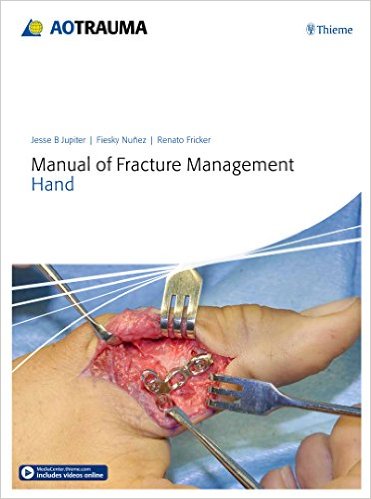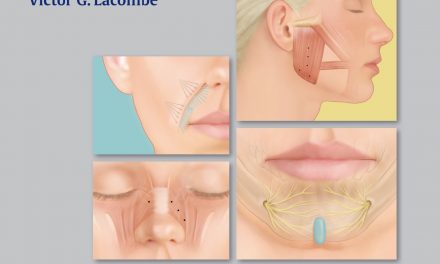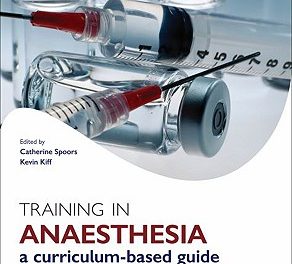Editors and Authors: Jesse B. Jupiter, MD; Fiesky Nunez, MD; and Renato Fricker, MD
Publisher: Thieme – 554 pages, with more than 2,250 illustrations
Book Review by: Nano Khilnani
This is a large, thick, comprehensive text on a wide range of fractures of the hand, from simple to quite complex. It is a book of more than 550 pages with 72 chapters, written and edited by three surgeons, and a fourth author from the United Kingdom, Dr Doug Campbell, who each have decades of experience.
This work has a very short table of contents, and we provide it below to give you an overview:
- Part I. Surgical Approach
- Approaches: 19 chapters
- Part II. Cases
- Proximal Phalanx: 17 chapters
- Proximal Interphalangeal (PIP) Joint: five chapters
- Middle and Distal Phalanx: four chapters
- Thumb: 10 chapters
- Metacarpals: 10 chapters
- Complex Injuries: two chapters
One of the top features of this book and what makes it extremely useful is the large number of illustrations. More than 2,250 images on almost every part of the human hand collectively provide you a rich learning experience. These are mainly black-and-white, partial-color and full-color sketches, but some are also photos. In addition to these, you will find images in the various chapters that indicate there are videos to be viewed.
The purchasers of this book can watch 26 surgical videos. Go to this website given below: www.MediaCenter.Thieme.com, and when prompted during the registration process, enter the access code found on the inside front cover of this book.
Accompanying the photos are detailed captions and instructions on surgical procedures of many kinds and varieties.
In Part I, the surgical approaches are mainly: dorsal, dorsoradial, dorsoulnar, midaxial, palmar, and radiopalmar.
In the Proximal Phalanx section (2) of Part II, the cases covered range from those of the base, the disphysis, metaphysis, bicondylar, and unicondylar sections of the hand. And the types of fractures covered are: articular, avulsion, intra-articular, oblique, and transverse fractures.
In the Proximal Interphalangeal Joint or PIP section (3) of Part Ii, the cases of dislocations, central impactions, and malunions shown are treated in various ways, including with lag screws or external fixation, palmar lag screws, reconstruction with hemihamate arthroplasty, and osteotomy and lag screws.
In the middle and distal section (3) of Part II, the open fracture, mallet fracture, and unicondylar fractures are shown as treated in several ways. The open fracture with bone loss is treated with a bridge plate and bone graft; one mallet fracture is treated with Ishiguro percutaneous K-wire; the other mallet fracture is fixed with a lag screw; and the unicondylar fracture is also treated with a lag screw.
In the thumb section (5) of Part II, 10 cases are presented, with various solutions to the fractures. Four of them relate to the proximal phalanx, and six to the metacarpal and base. The solutions range from using lag screws to locking compression plates (LCPs) such as the condylar plate or the T-plate, to the use of percutaneous K-wire.
In the metacarpals section (6) of Part II, various types of fractures are presented, such as base-intraarticular fracture, head-intraarticular fracture, long oblique and short oblique fractures, neck-malunion, shaft-nonunion, shaft-multifragmentary fracture, subcapital fracture, and transverse fracture. The treatments are varied, including the use of bridging plates, bone graft, intermedullary K-wire, lag screws, locking compression plates or LCPs, neutralization plate, and osteotomy, and T-plates.
This is an authoritative and comprehensive book on the management of fractures of the hand, with a very number of illustrations. It is a must-have for any medical student or resident intending to specialize in hand surgery, as well as for practitioners already in this field.
Editors and Authors:
Jesse B. Jupiter, MD is Hansjorg Wys/AO Professor of Orthopedic Surgery at Harvard Medical School and Massachusetts General Hospital in Boston, Massachusetts.
Fiesky Nunez, MD is Chief of Hand Surgery at DETRAU Centro Medico Guerra Mendezin Valencia, Venezuela.
Renato Fricker, MD is Consultant in Hand and Peripheral Nerve Surgery at Hirslanden Clinic Birshof in Munchenstein, Switzerland.
Contributing Author:
Doug Campbell, ChM, FRCS Ed, FRCS (Orth) is Consultant Hand and Wrist Surgeon at Leeds General Infirmary in Leeds, United Kingdom.







